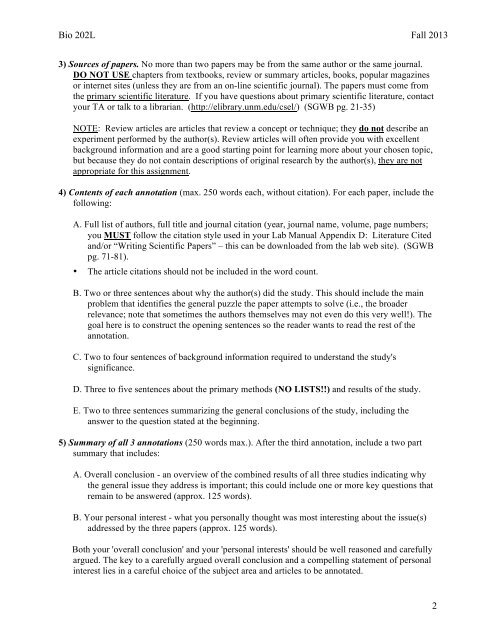Annotated Bibliography Guidelines
Annotated Bibliography Guidelines
Annotated Bibliography Guidelines
Create successful ePaper yourself
Turn your PDF publications into a flip-book with our unique Google optimized e-Paper software.
Bio 202L Fall 2013<br />
3) Sources of papers. No more than two papers may be from the same author or the same journal.<br />
DO NOT USE chapters from textbooks, review or summary articles, books, popular magazines<br />
or internet sites (unless they are from an on-line scientific journal). The papers must come from<br />
the primary scientific literature. If you have questions about primary scientific literature, contact<br />
your TA or talk to a librarian. (http://elibrary.unm.edu/csel/) (SGWB pg. 21-35)<br />
NOTE: Review articles are articles that review a concept or technique; they do not describe an<br />
experiment performed by the author(s). Review articles will often provide you with excellent<br />
background information and are a good starting point for learning more about your chosen topic,<br />
but because they do not contain descriptions of original research by the author(s), they are not<br />
appropriate for this assignment.<br />
4) Contents of each annotation (max. 250 words each, without citation). For each paper, include the<br />
following:<br />
A. Full list of authors, full title and journal citation (year, journal name, volume, page numbers;<br />
you MUST follow the citation style used in your Lab Manual Appendix D: Literature Cited<br />
and/or “Writing Scientific Papers” – this can be downloaded from the lab web site). (SGWB<br />
pg. 71-81).<br />
• The article citations should not be included in the word count.<br />
B. Two or three sentences about why the author(s) did the study. This should include the main<br />
problem that identifies the general puzzle the paper attempts to solve (i.e., the broader<br />
relevance; note that sometimes the authors themselves may not even do this very well!). The<br />
goal here is to construct the opening sentences so the reader wants to read the rest of the<br />
annotation.<br />
C. Two to four sentences of background information required to understand the study's<br />
significance.<br />
D. Three to five sentences about the primary methods (NO LISTS!!) and results of the study.<br />
E. Two to three sentences summarizing the general conclusions of the study, including the<br />
answer to the question stated at the beginning.<br />
5) Summary of all 3 annotations (250 words max.). After the third annotation, include a two part<br />
summary that includes:<br />
A. Overall conclusion - an overview of the combined results of all three studies indicating why<br />
the general issue they address is important; this could include one or more key questions that<br />
remain to be answered (approx. 125 words).<br />
B. Your personal interest - what you personally thought was most interesting about the issue(s)<br />
addressed by the three papers (approx. 125 words).<br />
Both your 'overall conclusion' and your 'personal interests' should be well reasoned and carefully<br />
argued. The key to a carefully argued overall conclusion and a compelling statement of personal<br />
interest lies in a careful choice of the subject area and articles to be annotated.<br />
2
















